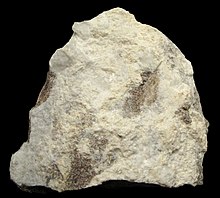
Prehnite is an inosilicate of calcium and aluminium with the formula: Ca2Al(AlSi3O10)(OH)2 with limited Fe3+ substitutes for aluminium in the structure. Prehnite crystallizes in the orthorhombic crystal system, and most often forms as stalactitic, botryoidal, reniform or globular aggregates, with only just the crests of small crystals showing any faces, which are almost always curved or composite. Very rarely will it form distinct, well-individualized crystals showing a square-like cross-section, including those found at the Jeffrey Mine in Asbestos, Quebec, Canada. Prehnite is brittle with an uneven fracture and a vitreous to pearly luster. Its hardness is 6.5, its specific gravity is 2.80–2.95 and its color varies from light green to yellow, but also colorless, blue, pink or white. In April 2000, rare orange prehnite was discovered in the Kalahari Manganese Fields, South Africa. Prehnite is mostly translucent, and rarely transparent.

Calcium hydroxide (traditionally called slaked lime) is an inorganic compound with the chemical formula Ca(OH)2. It is a colorless crystal or white powder and is produced when quicklime (calcium oxide) is mixed with water. It has many names including hydrated lime, caustic lime, builders' lime, slaked lime, cal, and pickling lime. Calcium hydroxide is used in many applications, including food preparation, where it has been identified as E number E526. Limewater, also called milk of lime, is the common name for a saturated solution of calcium hydroxide.

Manganite is a mineral composed of manganese oxide-hydroxide, MnO(OH), crystallizing in the monoclinic system (pseudo-orthorhombic). Crystals of manganite are prismatic and deeply striated parallel to their length; they are often grouped together in bundles. The color is dark steel-grey to iron-black, and the luster brilliant and submetallic. The streak is dark reddish brown. The hardness is 4, and the specific gravity is 4.3. There is a perfect cleavage parallel to the brachypinacoid, and less-perfect cleavage parallel to the prism faces. Twinned crystals are not infrequent.
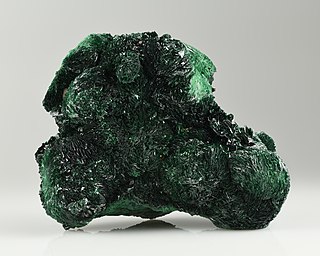
Atacamite is a copper halide mineral: a copper(II) chloride hydroxide with formula Cu2Cl(OH)3. It was first described for deposits in the Atacama Desert of Chile in 1802 by Dmitri de Gallitzin. The Atacama Desert is also the namesake of the mineral.

Powellite is a calcium molybdate mineral with formula CaMoO4. Powellite crystallizes with tetragonal – dipyramidal crystal structure as transparent adamantine blue, greenish-brown, yellow-to-grey typically anhedral forms. It exhibits distinct cleavage, and has a brittle-to-conchoidal fracture. It has a Mohs hardness of 3.5 to 4 and a specific gravity of 4.25. It forms a solid solution series with scheelite (calcium tungstate, CaWO4). It has refractive index values of nω=1.974 and nε=1.984.

Afwillite is a calcium hydroxide nesosilicate mineral with formula Ca3(SiO3OH)2·2H2O. It occurs as glassy, colorless to white prismatic monoclinic crystals. Its Mohs scale hardness is between 3 and 4. It occurs as an alteration mineral in contact metamorphism of limestone. It occurs in association with apophyllite, natrolite, thaumasite, merwinite, spurrite, gehlenite, ettringite, portlandite, hillebrandite, foshagite, brucite and calcite.

Brownmillerite is a rare oxide mineral with chemical formula Ca2(Al,Fe)2O5. It is named for Lorrin Thomas Brownmiller (1902–1990), chief chemist of the Alpha Portland Cement Company, Easton, Pennsylvania.

Bentorite is a mineral with the chemical formula Ca6(Cr,Al)2(SO4)3(OH)12·26H2O. It is colored violet to light violet. Its crystals are hexagonal to dihexagonal dipyramidal. It is transparent and has vitreous luster. It has perfect cleavage. It is not radioactive. Bentorite is rated 2 on the Mohs scale.

Botryogen is a hydrous magnesium sulfate mineral with formula: MgFe3+(SO4)2(OH)·7H2O. It is also known as quetenite.

Ettringite is a hydrous calcium aluminium sulfate mineral with formula: Ca6Al2(SO4)3(OH)12·26H2O. It is a colorless to yellow mineral crystallizing in the trigonal system. The prismatic crystals are typically colorless, turning white on partial dehydration. It is part of the ettringite-group which includes other sulfates such as thaumasite and bentorite.
Belite is an industrial mineral important in Portland cement manufacture. Its main constituent is dicalcium silicate, Ca2SiO4, sometimes formulated as 2 CaO · SiO2 (C2S in cement chemist notation).

Thaumasite is a calcium silicate mineral, containing Si atoms in unusual octahedral configuration, with chemical formula Ca3Si(OH)6(CO3)(SO4)·12H2O, also sometimes more simply written as CaSiO3·CaCO3·CaSO4·15H2O.

Spurrite is a white, yellow or light blue mineral with monoclinic crystals. Its chemical formula is Ca5(SiO4)2CO3.
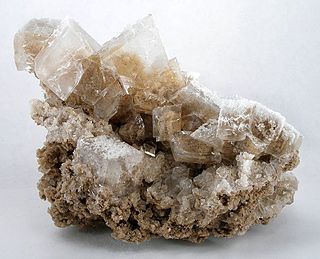
Meyerhofferite is a hydrated borate mineral of calcium, with the chemical formula Ca2B6O6(OH)10·2H2O, CaB3O3(OH)5·H2O or Ca2(H3B3O7)2·4H2O. It occurs principally as an alteration product of inyoite, another borate mineral.
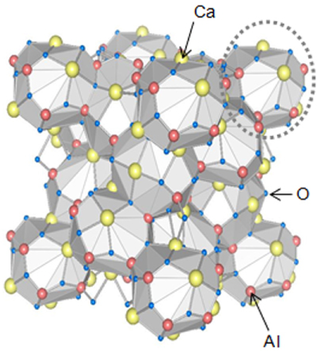
Chlormayenite (after Mayen, Germany), Ca12Al14O32[☐4Cl2], is a rare calcium aluminium oxide mineral of cubic symmetry.
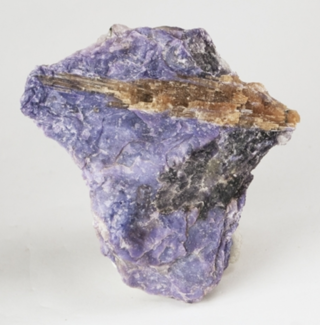
Tinaksite (chemical formula K2Na(Ca,Mn2+)2TiO[Si7O18(OH)]) is a mineral found in northern Russia. Tinaksite can be grayish-white, yellowish, orange, or brown, and it is often found in charoite. Its name is derived from its composition: titanium (Ti), sodium (Na) potassium (K) and silicon (Si). The International Mineralogical Association first recognized tinaksite as a mineral in 1965.

Grossite is a calcium aluminium oxide mineral with formula CaAl4O7. It is a colorless to white vitreous mineral which crystallizes in the monoclinic crystal system.
Larnite is a calcium silicate mineral with the formula Ca2SiO4. It is the calcium member of the olivine group of minerals.
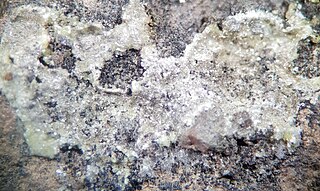
Znucalite or CaZn11(UO2)(CO3)3(OH)20·4(H2O) is a rare, radioactive, white to pale cream colored uranium-containing carbonate mineral, hydrated calcium zinc uranyl carbonate hydroxide. Znucalite crystallizes in the orthorhombic system, often forming aggregates or crusts, and is found as a rare secondary species in carbonate-hosted (meaning it is mined from carbonate containing formations such as limestone) polymetallic veins, and nearby oxidizing uranium veins; on dump material and coating mine walls, apparently of post-mine origin. It fluoresces yellow-green under UV light.

Scawtite is a hydrous calcium silicate mineral with carbonate, formula: Ca7(Si3O9)2CO3·2H2O. It crystallizes in the monoclinic crystal system as thin plates or flat prisms.
